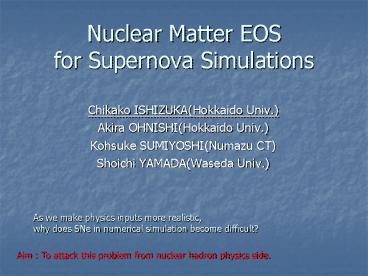Nuclear Matter EOS for Supernova Simulations - PowerPoint PPT Presentation
Title:
Nuclear Matter EOS for Supernova Simulations
Description:
As we make physics inputs more realistic, why does SNe in numerical ... Based on relativistic Bruckner Hartree-Fock. Checked by exp. data of unstable nuclei ... – PowerPoint PPT presentation
Number of Views:21
Avg rating:3.0/5.0
Title: Nuclear Matter EOS for Supernova Simulations
1
Nuclear Matter EOS for Supernova Simulations
- Chikako ISHIZUKA(Hokkaido Univ.)
- Akira OHNISHI(Hokkaido Univ.)
- Kohsuke SUMIYOSHI(Numazu CT)
- Shoichi YAMADA(Waseda Univ.)
As we make physics inputs more realistic, why
does SNe in numerical simulation become difficult?
Aim To attack this problem from nuclear hadron
physics side.
2
Successful hydro. simulation of core collapse SNe
? Long standing problem
Pure hydrodynamics (Success!) 1-dim. calc. with
dynamical neutrino transport (Failure!) Various
hydrodynamical mechanisms (In progress!) (e.g.)2-d
im. effects convection, rotation, magnetic
field What is a clue to solve this
problem? Nuclear physics inputs (e.g.)EOS,
neutrino production rate, neutrino
transport Lets examine whether these inputs are
proper, or not!
3
Nuclear matter properties related to supernova
simulations
Stable nuclei Unstable nuclei Hyperon
matter Meson condensation
Which information is necessary for SN
simulations?
Nuclear Pasta
Updated Exp. Data!
4
Why Are Hyperons Important in Dense Matter ?
EF
ML-Mn
n
L
n
Nucleon has large Fermi momentum and small mass.
Hyperon has small Fermi momentum and large
mass. Negative charged baryon and neutral baryon
is favored under high density circumstances.
5
Possible Role of Hyperons in Supernova
Hyperons would exist in Neutron Star Core -
Should appear during the cooling stage Density
and Temperature are High in the Collapse and
Bounce Stage (e.g. 2r0 in a calculation of
rotational core with strong magnetic field
(Kotake et al.)) - May appear even in the
Early (Bounce) Stage Hyperons Soften EOS - May
Increase the Explosion Energy
Let's Check it Out !
6
- Method Relativistic Mean Field Local-Density
Approx. - Shen, Toki, Oyamatsu, Sumiyoshi, 1998,
NPA, PTP - Based on relativistic Bruckner Hartree-Fock
- Checked by exp. data of unstable nuclei
- Nuclear structure mass, charge radius, neutron
skin,
7
Extension from SU(2) to SU(3)
Lagrangian (Shaffner et al.1996)
How to decide YN interaction
- Old
- conjecture
RMF using Lagrangian derived from SCL of lattice
QCD (Kawamoto et al., Tsubakihara
Ohnishi) DWIA with Optimal momentum
approximation (Maekawa Ohnishi)
8
Lagrangian derived from SCL of lattice QCD
- Less parameter model than TM1
- More reliable analysis of hyper nuclear data
9
DWIA with optimal momentum approximation
K
Optimal momentum
p Pp
?
q
On shell equation
Y
N PN
Ref. Gurvitz
Optimal elementary cross section
10
28Si(p-,K),S-quasi-free peak (KEK E438) Im.
W0-50,-30,-10 (MeV)
Maekawa 2004
30MeV
0MeV
Best fit!
Attractive S ? Bad
10MeV
-30MeV
11
S Potential Effects in Neutron Star
(RMF Sahu, Ohnishi Nucl. Phys. A691 (2001), 439.)
Repulsive Potential for ? ? ? does not appear
Attractive Potential for ? ? ? appears at around
r2r0
Max. Mass and Compositions are SENSITIVE to
Interaction !!
e.g. Nishizaki-Takatsuka-Yamamoto, PTP 108 (02)
703.
- UL-30MeV ? UL-28MeV
- US-30MeV ? US3090MeV
- UX-30MeV ? UX-15MeV
12
Neutron star matter
Thermal pions Interaction with nucleon ?NO! EOS
keep the stiffness
1.44
Max. neutron star mass 1.44Msolar ? OK!
13
Hyperon, pion ? Softening EOS at high
densities (Pauli principle, pion
condensation) Muon ? Softening EOS at low
densities Neutrino? Making EOS Stiff at low
densities
1dim. Spherical hydro. calc. (Sumiyoshi 2004)
adiabatic expansion (without neutrino transport)
Initial model WW95 Small difference of EOS
change the result!
14
SN explosion energy gain due to EOSs
Explosion energy
Hyperons, pions increase Eexp by (0.1-0.5),
respectively Muon suppress the explosion (In the
present hydro. model, rmax1.3r0. In more
realistic model, rmax2r0 ? More energy gain
due to EOS are expected!
15
Summery of this talk
- Relativistic EOS table containing nuclear matter
properties - from low densities (various nuclei in bubble
phase) - to high densities (hyperon matter or meson
condensation) - within an ambiguity of YN interaction at present.
- -Hyperon-nucleon interactions suggested by
- DWIA with optical momentum approx. analysis
- and RMF based on strong coupling limit of
lattice QCD. - Supernova phenomena based on the consistent
picture - with the recent progress in strangeness nuclear
physics. - Percent order explosion energy gain is obtained
- due to softening of EOS by hyperons and pions
- in 1-dim. spherical core collapse and bounce
simulations. - Hyperon contribution can not be neglected in
- more realistic supernova simulations
- including black hole formation.
16
Current study and interest
- Pion contribution can not be included in
- a usual framework of RMF
- - Correlation between nucleons and pion
- in a new framework of RMFpi
- ? may make EOS softer than thermal pions do.
- Improvement of low density part is needed!
- Statistical feature becomes strong
- under finite T and low density conditions.
- -Thomas-Fermi approx. works well near T0MeV.
- ? NSERMF EOS table may be clued to successful
SNe! - - closely related with electron capture.

